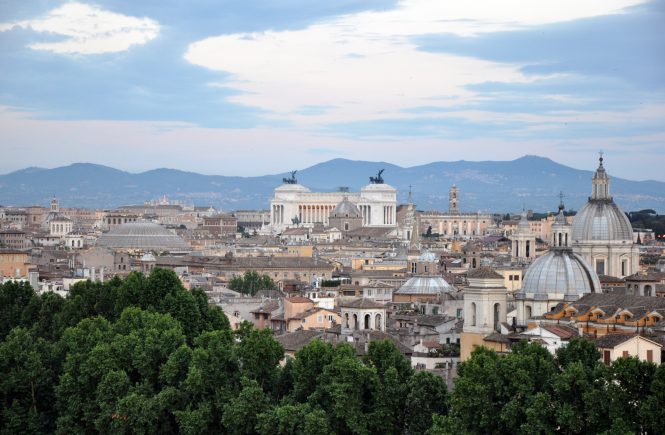
If you get nightmares — or nausea — easily, don't visit the Basilica of Santo Stefano Rotondo.
Think you can handle it? Then welcome to some of the most graphic frescoes of 16th-century Rome.
First, though, there's more to this church than its frescoes. Built on top of the remains of a 2nd-century Mithraic temple (currently being excavated), the church was built in the fifth century A.D. to hold the body of Saint Stephen, which just had been brought to Rome from the Holy Land. The church's architecture is particularly unusual. As Rome's first circular church, it was modeled after Jerusalem's Church of the Holy Sepulchre. (Back then, with another entire ambulatory besides the two there today, it would have been much larger).
Santo Stefano in Rotondo also holds some odd treasures: a 6th-century mosaic of St. Primus and St. Felicianus; the tomb of Irish king Donough O'Brien, who died in Rome in 1064; a chair of Pope Gregory the Great from 580.
But if you go to the church, you could miss all of this for its frescoes.
Spiraling around the circular walls, the paintings depict 34 different martyrs — each being killed in gruesome ways. (Molten lead poured down the throat? Check. Breasts cut off? Check. Boiled alive? Check!) Commissioned by Pope Gregory XIII near the end of the 16th century, the paintings are naturalistic in their graphic displays, making anyone who looks closely enough wince. The peaceful expressions on most of the martyrs' faces go somewhat toward mitigating the"ouch ouch OUCH" effect… although in all honesty, I find that eerie calm a bit more disturbing than convincing. 
Charles Dickens may have put it best, writing of his visit of the "hideous paintings" that cover the walls. He wrote,
…such a panorama of horror and butchery no man could imagine in his sleep, though he were to eat a whole pig raw, for supper. Grey-bearded men being boiled, fried, grilled, crimped, singed, eaten by wild beasts, worried by dogs, buried alive, torn asunder by horses, chopped up small with hatchets: women having their breasts torn with iron pinchers, their tongues cut out, their ears screwed off, their jaws broken, their bodies stretched upon the rack, or skinned upon the stake, or crackled up and melted in the fire: these are among the mildest subjects.
So, what do you think: Can you handle it?
If you can, remember that Santo Stefano Rotondo is closed Mondays and Sunday afternoons; otherwise, it's open from 9:30am-12:30. It's also open 3pm-6pm in the summers, and 2pm-5pm in the winter. The address is Via di Santo Stefano Rotondo 7, about a 10-minute walk from the Colosseum or from San Giovanni in Laterano, and right nearby the Basilica of Santi Quattro Coronati. For more information about the church, click here. For a map, click here.
You might also like:
Hidden Underground in Rome, an Ancient Sepulchre
Siena: A Gem of the Tuscan Countryside
A Medieval Church with More than Meets the Eye: St. George in Velabro


5 comments
Maybe Santa Costanza at St Agnese fuori le mure was earlier
http://www.sacred-destinations.com/italy/rome-santa-costanza
Yes, definitely a possibility! Thanks for pointing that out, and stay tuned for a future post on Santa Costanza…
We virtually stumbled upon St Stefano’s, last Sunday. Dickens and others failed to reflect on why these paintings were painted. I am surprised at Dickens’ lack of understanding (and that from a man who used darkly honest descriptions to highlight the injustices of his own day). St. Stefano is perhaps the closest church to the Colosseum and other sites of torture and where better to depict the most horrendous tortures that were inflicted on Christians. It seems to me legitimate- no, desirable, to graphically describe those dark deeds, lest we forget the real measure of both torture and fortitude of those dark days. Through these images we can revisit the past and become conscious also of the present, a present when such tortures are being inflicted with just as fiendish, unreflecting determination. Does art always need to be sanitised? An artist is entitled to his expression and to his outrage.
Hi John, thanks for your comment! It’s definitely an interesting idea, though it is worth noting that there’s actually no evidence that Christians were tortured or martyred in the Colosseum (other parts of Rome, including where St. Peter’s Square is, yes; the Colosseum, no), and most modern historians don’t think that happened there. But you’re certainly right that, at different periods during the Roman empire, Christians were executed, so it’s not surprising at all for images of martyrdom to have been painted in Rome itself. I’m glad you stumbled on Santo Stefano, and thank you so much for sharing your thoughts!
Hi, Amanda! I loved your website and all your posts.
Do you know if the Saint Stephen’s body (the protomartyr) is buried there?
Or was the church just dedicated to him?
Best wishes!
Cleber